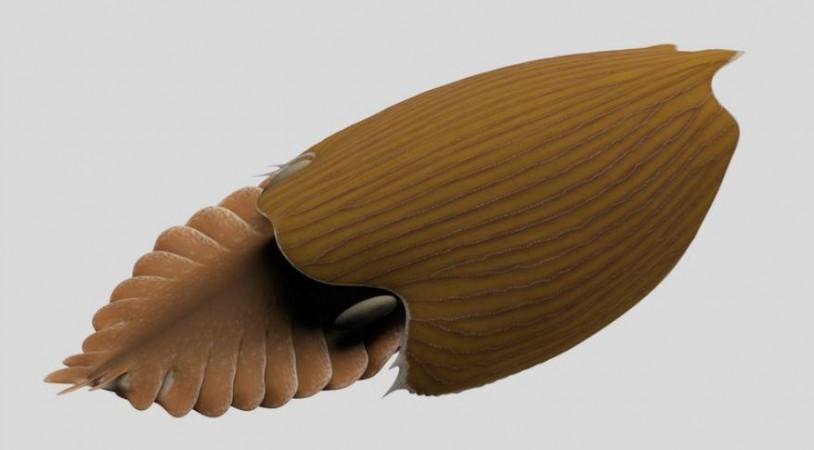When most people talk about prehistoric life on Earth, dinosaurs are the first creatures that come to mind. However, life began and flourished in the oceans millions of years earlier. While not massive by later reptilian standards, several gigantic species of early animals thrived in Earth's waters. Now, scientists have unearthed the fossil of a massive species of ancient predator that lived around half a billion years ago.
Paleontologists from Royal Ontario Museum (ROM) have reported the discovery of a new species within an extinct animal group, Radiodonts. Christened Titanokorys gainesi, the species is remarkably large for the era and prowled the waters during the Cambrian period (540 million to 485 million years ago). With an approximate length of half a meter (around 1.6 ft), it was enormous compared to most animals that dwelled in the seas, which grew only to lengths of a few centimeters.
"The sheer size of this animal is absolutely mind-boggling, this is one of the biggest animals from the Cambrian period ever found," said Dr.Jean-Bernard Caron, corresponding author of the study, in a statement. Titanokorys' remains were discovered in the Kootenay National Park, Canada. The findings were published in the journal Royal Society Open Science.
An Ancient Giant

Titanokorys belongs to a primitive group of arthropods that formed an extinct order known as Radiodonta. Arthropods are invertebrates that have jointed legs, a segmented body, and an exoskeleton. Insects, arachnids (such as spiders and scorpions), crustaceans (such as prawns and crabs), and myriapods (such as millipedes and centipedes) constitute the organisms in the phylum. Radiodonts consisted of some of the earliest large predators in Earth's evolutionary history and thrived during the Cambrian period.
These creatures possessed distinguishable features such as complex compound eyes, a pair of large and segmented appendages (spiny claws) below their head to capture prey, a circular mouth with serrated teeth, and a squid-shaped body containing a series of flaps for swimming. The most archetypal example of the group is Anomalocaris. It may have been nearly one meter (3.3 ft) long and is said to have inspired the creation of the Pokemon Anorith.

Titanokorys was also found to have the attributes characteristic of the group. While most Radiodonts managed to reach lengths of a few centimeters, Titanokorys was half a meter (around 1.6 ft) in length. Among Radiodonts, few species also have large and noticeable head carapaces (hard upper shells). Titanokorys is said to be one of the largest known species within this niche cluster.
Joe Moysiuk, co-author of the study, explained, "Titanokorys is part of a subgroup of radiodonts, called hurdiids, characterized by an incredibly long head covered by a three-part carapace that took on myriad shapes. The head is so long relative to the body that these animals are really little more than swimming heads."
Built for Hunting on the Ocean Floor

While some species of radiodonts evolved a bizarre array of head carapace sizes and shapes, the factors driving this diversity remain poorly understood. Nevertheless, researchers postulate that a broad and flattened carapace shape in Titanokorys indicates that it was a species that had adapted to a life close to the seafloor.

"These enigmatic animals certainly had a big impact on Cambrian seafloor ecosystems. Their limbs at the front looked like multiple stacked rakes and would have been very efficient at bringing anything they captured in their tiny spines towards the mouth. The huge dorsal carapace might have functioned like a plough," illustrated Dr. Caron.

Another more abundantly prevalent relative of Titanokorys, Cambroraster falcatus, had been discovered in the same region previously. Cambroraster falcatus' name is a nod to the Millennium Falcon, owing to the close resemblance of its head carapace's shape to the Star Wars vessel. According to the team, it is likely that these two predatory species competed with each other for similar prey that dwelled on the ocean floor.
Window into A Lost Ecosystem

The fossils among which the newly-discovered specimen was found were excavated around Marble Canyon in Kootenay National Park, Canada. The park is an outcrop of the Burgess Shale—a fossil-rich deposit in the Canadian Rockies of British Columbia—that is a designated UNESCO World Heritage Site. An ecosystem that existed for a brief period following the proliferation of multicellular life on Earth is captured within the fossils in the area.
Unearthed less than a decade ago, Kootenay National Park has served as a treasure trove of several varieties of Burgess Shale animals that can be dated back to the Cambrian period. Therefore, these organisms predate dinosaurs by millions of years. Yoho National Park is another important outcrop of the Burgess Shale deposits.





!['Had denied Housefull franchise as they wanted me to wear a bikini': Tia Bajpai on turning down bold scripts [Exclusive]](https://data1.ibtimes.co.in/en/full/806605/had-denied-housefull-franchise-they-wanted-me-wear-bikini-tia-bajpai-turning-down-bold.png?w=220&h=138)



